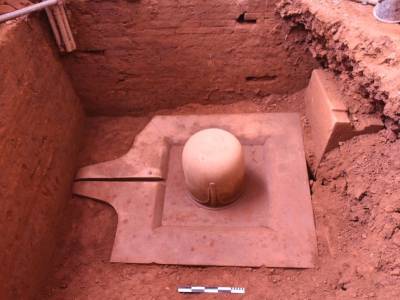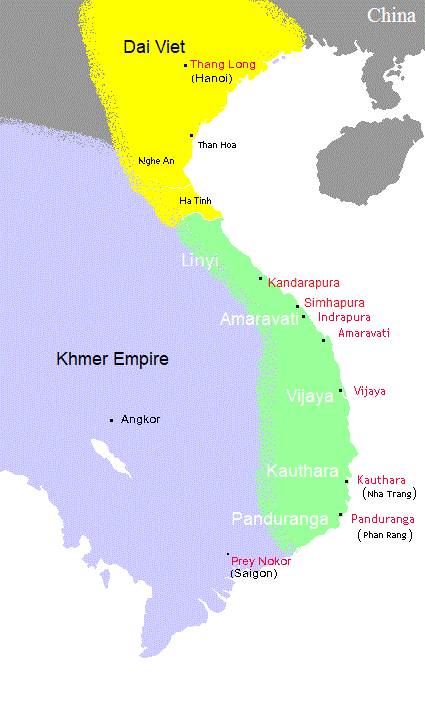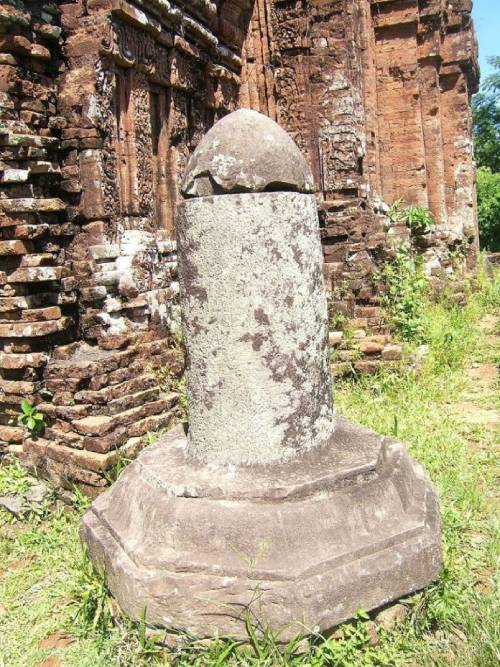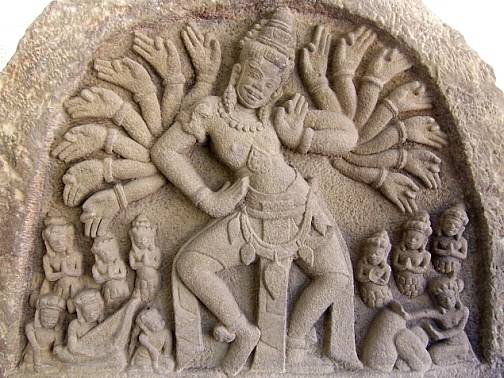By Monidipa Bose Dey for OpIndia

There are various archaeological findings that prove the existence of a pre-historic culture in Vietnam, which includes the discovery of the remains of Hoabinhian culture in the Ha son Binh province, bronze artefacts in Hang-Goam dating back to 3rd millennium BCE, and early rock shelters. Apart from these, various excavations have yielded bronze items in the form of drums, bracelets, daggers with human figures as hilts, bowls, and miniature bells dating around 600 BCE.
There were cultural interactions between Vietnam and China during the third century BCE, as evident from pottery remains that are similar to the geometric patterns seen on South China potteries. Vietnam came under direct Chinese control mainly during the rule of the Han dynasty, when the Chinese Han emperor Liu Che (also known as Wu Ti) conquered North Vietnam in 111 BCE.
Owing to this occupation, northern Vietnam was deeply influenced by the Chinese culture; however, southern Vietnam remained free from any such Chinese control or influences. Despite the cultural influences, the Vietnamese people never really accepted Chinese rule, leading to constant rebellions and skirmishes, which finally ended the Chinese control in 939 CE, after which the country took the name Dai Viet.
The Kingdom of Champa and the Chams
Meanwhile, in the far east coast of Vietnam, a Hindu kingdom that was established in the 2nd c. CE was flourishing and was known as the Kingdom of Champa, with its capital city at Champapura or Champenagari. This ancient kingdom of Champa was most likely the Angadvipa, which is found mentioned in the Vayu Purana.
The kingdom extended along the eastern coast of Vietnam from the centre to the south and was divided into several parts, of which Quang-Nam was considered as the holy land of the Chams. Other parts included Amaravati in the north; and Panduranga, Kauthara, Vijaya, and Indrapura in the south. The people of this kingdom were known as the Chams, and owing to the strong trade connections that they had developed with ancient India, they became deeply influenced by the Hindu religion, as evident from their religious practices and artworks.
The Chams were mostly farmers, fishermen, and master temple builders and sculptors. Evidence of their skilled workmanship is still visible in the remaining temples that are seen in Vietnam and Cambodia even today. During its heyday, the kingdom of Champa was a famous centre for global trade, with connections to all important seaports of that era.
The Chams developed a widespread trading network, that extended to Japan, Taiwan, India, China, Indonesia, Philippines, and Malaysia. Many old shipwrecks stand as evidence of the thriving trade that once existed between Philippines and Champa. On such shipwreck found off the coast of Palawan (Philippines), was found carrying green-glazed ceramics from Vijaya of the Cham kingdom, which was dated between 1450-1470 CE.
Historically it is believed that the Chams were descendants of Sa Huynh, an ancient community that migrated from the Malay Archipelago to the eastern coast of Vietnam by taking the sea route, roughly around 1000 BCE, mainly to establish commercial and trade relations between China, Malay Archipelago, and the Annamite (Vietnam) Highlands. The Chams remained in the same eastern coastal area from the time they arrived in Vietnam, to the second century CE, when they finally established their political entity as the Cham Kingdom, that continued unbroken for almost thirteen hundred years (150-1450 CE).
While locally it is believed that the founder of the Cham kingdom was Kiu Lien who established his capital near Hue, however, there is no consensus as regards his true identity and name. The first historically recorded king of Champa is considered to be Sri Mara (2nd c. CE), and it was he who got rid of the Chinese from his area.
After the Han Dynasty ended in China (around 220 CE), the kingdom of Champa started expanding further, and a naval attack by the Champa king in 248 CE resulted in the defeat of China. The struggle for territorial power continued between the Chams and the Chinese for another decade, after which the Chinese power went into complete decay.

The most famous king of the Cham dynasty was Bhadravarmana, and it was during his reign that the Chams were introduced to Indian culture, and adopted Hinduism as their religion. It was Bhadravarman who constructed a beautiful and impressive temple dedicated to Shiva at Mi-son around 600 CE. The temple was declared as the national religious monument of the Chams, and the deity was named Bhadresvarasvamin after their king.
Like Indian kings, the Cham kings also added the title Varman after their names. Bhadravarman’ s son Gangaraja in his later life gave up his kingship and travelled to India to spend his last days near the river Ganga. After Gangaraja left, the Champa kingdom broke down into fragments, with many smaller Hindu kingdoms (such as the Panduranga and Vhrigu dynasties) ruling the territories, instead of one central monarchy. Owing to this, the glory of the capital city of Mi-son also faded from 8th c. CE onward.
The Panduranga dynasty 757 – 860 CE) rebuilt many of the temples, and reinstalled murtis destroyed by the Javanese seamen. They followed an aggressive policy towards China and Kambuja, leading successful expeditions against them. Under the Vhrigu dynasty (860 – 985 CE) Champa again became a powerful kingdom, especially during the rule of Bhadravarman III (905- 910 CE). Various inscriptions have been found that detail his war wins and talks of many foreign ambassadors present in his court.
His son Indravarman III who was a noted scholar of his times and well versed in Sanskrit works and Buddhist philosophies, faced attacks from the Kambuja empire that caused extensive damages to his kingdom. His son Paramesvaravarman faced attacks by the Annamese (north Vietnam- Dai Viêt) and was killed in the war, and the kingdom ravaged.
The Annamese continued ruling large parts of the Champa kingdom until 989 CE when a local Cham leader Vijaya Sri Harivarman II defeated them and took control. The Annamese regained their control of the Champa kingdom in the 13th century, only to lose it to the Mongols who conquered Champa in the 16th century.
The Kingdom of Champa got merged with Dai Viet/ Vietnam in the 17th century, even though unofficially the Cham territory remained as a separate entity in Vietnam until 1883. Vietnam still has a small percentage of the Cham community living there, though most had fled to the Malay peninsula, Java, isle of Hainan, Cambodia, and Sumatra after facing persecution from the Vietnamese in the 17th century.
In the 20th century, the Chams again faced persecution when they became victims of the widespread massacre in Cambodia under the Communist rule of the Khmer Rouge group (1975 to 1979), who wanted to remove all non-Khmer people from Cambodia. While currently the Chams are relatively doing better in Vietnam, they still face constant pressure to assimilate completely with the Vietnamese culture.
Art and architecture of the Chams : Striking similarity to Eastern Indian and Dravidian temple styles
The Cham built temples have a distinct architectural style with brick bodies and shikaras, which is completely in contrast to the Khmer people (another Hindu kingdom) of Cambodia where stones were mainly used for constructing temples. The remains of the Cham temples can still be seen scattered around Vietnam and Cambodia.
Among them, the 6th-century Mi-Son temple is considered as the oldest surviving monument in Southeast Asia, and clearly showing the influence of Hinduism in particular and Indian culture in general. It is however sad to note that many of the Cham temples and their sculptures, along with other artworks have been destroyed or damaged during the various wars that took place during the 20th century.

A closer look at the temple architecture and sculptures of the Champa kingdom shows an influence of the Pala Bengal style, Odisha Kalingan forms, and the Dravidian architectural style. Historians have observed that the 10th-12th century era temples in the remote villages of Deulghata (Purulia district), and Sonatpal village (Bankura district) of West Bengal are similar in architectural design with the Champa temples of the Bin-Dinh area. Another major connection is likely to be the practice of Sakta and tantra worship that were prevalent both in the Bengal as well as in the Champa kingdom at the same time.
Besides the Sakta worship, Shaivism and Vaishnavism were also in practice in the Champa kingdom, and an image of a ten-armed Shiva (11th c. CE) in the Thap Banhit temple bears the distinct style of the Pala school of Art. Older temples of the Champa kingdom (around 7th-8th c. CE) show the Dravidian style of temple architecture, and in this context, RC Mazumdar had opined that the origin of the Champa temples was likely to have been influenced by the Pallavan temple architecture seen in Mahabalipuram and Kanchipuram of Tamil Nadu. The 7th-century rock-cut temples of Mahabalipuram and Champa temples are architecturally similar to each other.

With some recent disturbing news on Twitter that speaks of the old Cham temples facing destruction in Vietnam, it is now imperative that these remaining temples are immediately declared as protected heritage sites. Perhaps the Government of India can play a more active role in the conservation of these temples that have a connection with Bengal, Odisha, and Tamilnadu from the early medieval times when there were strong trade and commercial links of these areas with the Champa kingdom.
References
R.C. Majumder (ed.), The Age of Imperial Unity. Bombay, 1968.
R.C. Majumdar. Hindu colonies in the Far East. Calcutta, 1944.
H.B. Sarkar. Cultural Relations Between India and Southeast Asian countries. New Delhi,
1985.
P. Brown. Indian Architectures, (Buddhist and Hindu Period). Bombay, 1971.





